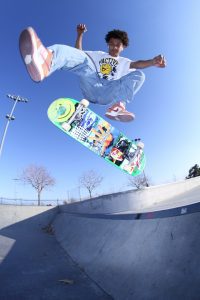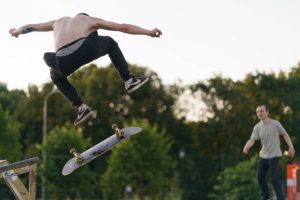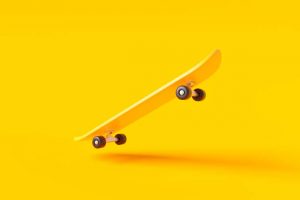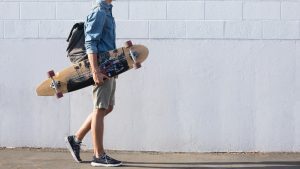Are you a skateboarder? Do you want to ride with flair? Are you excited to dive into the world of skateboarding? At FamilyHype, we’re passionate about providing skate-style resources to help riders define their skateboarding style and make it their own. This sport is not just about fun. There’s a personality in every skate, so ride your best. Are you ready? Let’s go!

This sport is absolutely one of the best you can try. By learning to skate with style, you’ll open a new perspective and activity to hone your skills and immerse yourself in skate culture, diverting your mind from the daily stress of life. Read on and enjoy some good information from these ultimate guidelines.
In this skater style ultimate guide, we’ll cover skateboard styles, choosing and customizing your skater aesthetic, mastering basic skate tricks and styles, maintaining your ride, and expressing yourself through it. Embracing skater fashion means opting for loose fitting clothes like baggy pants and graphic tees, and incorporating baggy jeans and ripped jeans into your wardrobe. The skater aesthetic isn’t just about the tricks; it’s also about how you present yourself on and off the board. Whether you’re a newbie wanting to learn or an old hand looking for a refresh, you’ll find something here.
Before you hop on a skate, it’s crucial to understand the various skateboard styles available and identify the one that best suits your needs and personality. A popular skateboard style includes street, vertical, and cruising.
Longboarding Style Is A Personal Art For Expert Skaters
- It’s time to define our skater style and hit the pavement with confidence and style.
- Skateboarding style has evolved into various styles over the years, each of the skate brands offers unique experiences and a set of styles for the riders. Recognizing your desire is necessary for choosing the right skate and cultivating your respective riding preferences.
- Street skateboarding involves performing tricks on stairs, ledges, railings, and other urban obstacles commonly found in city landscapes. This skater style requires a certain level of precision and creativity since style skaters must adapt to their environment.
- Vert skateboarding takes place on ramps or half-pipes with steep inclines that enable skaters to launch themselves into mid-air stunts such as spins, flips, and high-flying grinds. It demands extraordinary balance, aerial awareness, and courage from its practitioners.
- A blend of street and vert skating style elements can be found in skate parks, usually within designed skate parks consisting of a mix of ramps, bowls, stairs sets, or transition sections tailored for varied maneuvers.
- Regularly inspecting skate wheels, skate bearings, and skate trucks for signs of wear or damage; adjusting tightness as needed to guarantee versatile and comfortable ride and maintain stability in a wide skate parks.
Stylish Skater’s Dream: Skateboarding Style
You’ve got to know there’s more to skateboarding culture than just riding; it’s an art with a multitude of styles that will blow your mind. Get on with style!

We’re talking about the rich skateboarding culture here, filled with diversity and creativity. It’s crucial to understand different styles for effective skateboarding safety. Regarding skateboarding culture, many different styles and approaches can be taken. The possibilities are endless in skate culture, from freestyle skateboarding to street skateboarding to vert skateboarding.
Freestyle Skateboarding
Freestyle skateboarding is arguably the most creative form of skateboarding in skate culture, where a style skater boy focuses on flat-ground tricks and maneuvers only limited by their imagination. Rooted in the early days of skateboarding, this skater style revolves around technical skills and fluidity of motion.
Freestyle skateboarding seamlessly intertwines functional clothing with a distinctive skater style and looks like Tony Hawk, and looks like a skater boy, which has become an iconic part of pop culture. Embracing bold patterns reminiscent of hip hop influences, skaters effortlessly blend old school vibes with high style, donning not just any T shirt but often sporting stylized pieces from renowned brands like Louis Vuitton. Their look is completed with loose fitting, baggy jeans or ripped jeans, showcasing the skater aesthetic. Baggy pants and a general skater fashion sense underline their unique approach to style.
Street Style Skateboarding
Street skateboarding has gained massive popularity since the 1980s and remains one of today’s most common styles. This approach incorporates elements from urban skating landscapes like handrails, stairs, ledges, benches, or other obstacles one might find in a cityscape. Skaters often make a statement with their unique choice of clothing and accessories, embodying the essence of the skater boy lifestyle, which is typically designed for both style and durability. Skate brands offer a variety of options, from classic shirts and hoodies to baggy jeans and baggy pants, ripped jeans, and graphic tees, that embody the skater aesthetic, perfect for loose fitting casual wear.
Complete your look with hats, beanies, and backpacks, like Tony Hawk, making it easy to shop for the top skater gear. This type of skater attire often includes well-crafted pieces that have become key items in the skater’s wardrobe, such as board shorts and the typical skater shoes in skate culture. With the right and ultimate guide, you can find the ideal mix of comfort and performance in your skater gear, ensuring each skater boy is always ready to hit the streets in style.
Street skateboarding has evolved with a modern twist, as style skaters now opt for oversized T-shirts, skate shorts, and classic Vans, embracing graphic tees that pay homage to icons like Tony Hawk. This contemporary style allows skaters to showcase their individuality while navigating the urban landscape with a fresh and expressive approach.
Vert Style Skateboarding
Vert skating, or “vertical” skateboarding, focuses on performing aerial tricks while riding up and down steeply inclined surfaces like halfpipes or quarter pipes connected to ramps at right angles providing top-to-bottom transitions called “transitions.” To dress like a skater, many enthusiasts look to skater fashion icons like Tony Hawk. Embracing a relaxed fit, loose fit, and skate-inspired clothing, they often choose cargo pants and a graphic tee to make a fashion statement.
Brands like Vans are popular in the world of skater fashion, offering the perfect blend of comfort and style. The guide to skater fashion emphasizes the importance of mix and match outfits, blending mainstream fashion with skater style, style not only resonates within the community but also influences broader mainstream fashion trends, making it easy for anyone to adopt the style and dress like a skater.
Skateboarders Riding Style
When it’s time to pick out that perfect skate style, there’s a lot to consider for the ultimate shredding skating experience in skate culture. Skate durability is paramount, ensuring your ride withstands all you throw at it. Skate style selection also matters as the right skateboard can support and enhance your skateboarding style. It’s a combination of the right shape, style, size, material, and graphics that make a skate truly yours.
Consider the following aspects:
- Length: If you’re into street skating, opt for longer skates, while shorter skates suit cruising and carving.
- Width: Wider skate decks increase beginners’ stability because they offer more foot space & guidance.
- Wheelbase (the distance between two inner sets of trucks): Longer wheelbase skater guides smoother rides since it has less resistance against bumps and debris; wider wheelbases are preferable in avoiding curbside scrapes due to their height adjustment capacity.

Customizing a skate deck concave can ensure excellent traction underfoot tailored to support an individual’s skate style:
- A shallow concave suits beginners who require stability.
- A deep concave is well-suited for advanced skaters opting for improved turnover and grab.

Customizing Skateboard Style
Customizing your skate style isn’t just about personal style; it also reflects who you are as a style skater and an individual like Tony Hawk, the greatest of all time. We encourage creating a unique skater boy look that serves others and gives you the confidence you need to master the basic style.
To get you started, consider the following:
- Deck artwork: This is the visual representation of your personality on wheels.
- Grip tape customization: Use this opportunity to add functional flair to your ride.
- Hardware: Choose from different materials and colors to give your skate a distinct look.
Whether you’re a beginner or a pro, customizing your skate is a great way to express yourself and stand out from the crowd.

Basic Skateboarding Styles
Mastering basic skateboarding tricks isn’t just about showing off; it’s an exciting journey of self-discovery and determination that can truly transform you.
Ollie
The ollie is a foundational trick for most skateboarders and an essential skill to learn first. To execute an ollie:
1. Position your back foot on the skateboard’s tail while your front foot stays in the middle. Don’t forget to wear skate shoes.
2. Bend your knees and lean slightly forward.
3. Snap down on the tail with your back foot while lifting up with your front foot.
4: Slide your front foot up towards the nose of the skateboard, leveling it out in mid-air.
5: Land on all four wheels simultaneously.

Kickflip
Once you’ve mastered ollies, kickflips are typically next in line for skaters to learn:
1. Begin like you’re preparing for an ollie, but position both feet with skate shoes on, of course, angled slightly inward toward each other.
2: Execute an ollie by tapping down on the tail and sliding your front foot toward the nose.
3: With a quick flick movement using only your toes, snap outward under the skate’s outer edge to send it spinning underneath you.
4: Watch for when the skate completes one full rotation; then reposition both feet onto all four wheels simultaneously.
Skateboards And Skate Shoes

Ensuring your skate shoes are in excellent condition is essential to mastering those skateboarding tricks you’ve been working on. Pairing them with cargo pants or ripped jeans, along with a graphic tee, will help you nail the skater style skater aesthetic while perfecting your moves. This style not only stands out but also aligns with mainstream fashion trends, making it a versatile fashion statement. To truly dress like a skater, embrace a relaxed fit and loose fit clothing, which are key elements of skate inspired fashion.
Brands like Vans are staples in the guide to skater fashion, offering pieces that perfectly capture the essence of the style, style trends. Additionally, skate cleaning and bearing replacement are two ways to serve our ride, keeping it smooth and responsive. After all, taking care of our equipment means we’re also looking out for others who share the skate park with us.
Regular Inspection
Take a close look at your skate as a whole and its components, including the bearings, wheels, trucks, and deck. Check for any cracks or deformities that can impact the performance or safety of the skate.
Cleaning Bearings Regularly
Maintaining a smooth ride with skate shoes depends on keeping your bearings clean and well-lubricated. Remove each wheel from the trucks and the bearings from within with a bearing tool or other such instrument. Once out, use a good solvent to clean the bearings and remove debris. Before using a premium lubricant, ensure the bearings are dry after cleaning. Put the wheels back onto the trucks and reassemble the bearings inside them. Routine cleaning and lubricating your skateboard will guarantee a smooth and pleasurable ride.
Conclusion
Skateboarders, it’s time to confidently and elegantly update your ride! Regardless of your skill level—from newbies eager to learn to expert skaters looking to advance—this article has provided you with important guidance and insights. We have covered choosing the best style of skateboard to pick up the basics of tricks and maintaining your skateboard. Opt for a unique board that reflects your personality, ensuring it is both functional and durable. Brands like Vans offer skateboards known for their durability and modern designs, making them a great choice for skaters of all levels.
Remember, skating is not just about performance but also about style. Pair your vintage or modern board with loose fitting, baggy jeans, and a tee featuring a bold logo for that laid-back look. Don’t forget to wear comfortable shirts that allow free movement. Here are some tips: ensure your skateboard’s fit aligns with your body size and skating style, and choose gear that complements your aesthetic. Whether you’re looking at skateboards for men or unisex options, focus on finding a board that enhances your skating experience and showcases your unique style.
Skating can encourage creativity, enjoyment, and a sense of community. Get on your skateboard now, take to the streets, and let your skating style shine with a laid-back attitude.
Frequently Asked Questions (FAQs)
What Defines Skater Style?
Skater style embodies a blend of comfort and functionality, making it a distinct fashion statement. Essential pieces include cargo pants and a graphic tee, which together create a relaxed fit perfect for both skating and casual wear. To truly dress like a skater, one must embrace the skate inspired elements that define this look. This quality style & style trends are not just about clothing but an attitude, a way of life that resonates with those who follow the guide to skater fashion. Whether you’re on the board or off, skater style offers a unique blend of practicality and flair, making it a lasting trend in the fashion world.
What Style Do Skateboarders Wear?
Skateboarders typically wear a skate inspired look that balances comfort and durability. Cargo pants are a popular choice for their practicality and relaxed fit, allowing for easy movement while performing tricks. To dress like a skater, it’s essential to adopt the skater style skater look, which often includes loose-fitting clothes and layered outfits. This style & style trend aren’t just about fashion; it’s about expressing a laid-back attitude and a connection to the skateboarding culture. Embracing this style means prioritizing both function and flair, ensuring that you can ride with ease and look great doing it.
How Do You Choose Your Skateboard?
How Do You Pick Board Length?
How Do I Know If My Board Is Too Small?
How Do I Choose A Skateboard For My Child?
How Do You Know If A Skateboard Fits You?
What Are The Essentials Of Skater Fashion?
Skater fashion essentials include loose fitting baggy jeans or shorts, graphic tees, baggy pants, ripped jeans, hoodies, and sneakers. This aesthetic embodies a casual yet edgy look that reflects the skateboarding culture. Accessories like beanies, snapback hats, and skate shoes are also key to completing the outfit. For those new to this style, a guide to skater fashion can help navigate the various elements that make up this unique statement. Whether you’re shopping at your local skate shop or exploring the world of online stores, understanding these essentials will help you fit right into the skater culture. This fashion isn’t just about clothes; it’s about embracing a lifestyle that values individuality and freedom.
How Many Styles Of Skateboarding Are There?
How Do I Find The Perfect Skateboard?
Last Updated on June 30, 2024 by Harold Chan
DISCLAIMER (IMPORTANT): This information (including all text, images, audio, or other formats on FamilyHype.com) is not intended to be a substitute for informed professional advice, diagnosis, endorsement or treatment. You should not take any action or avoid taking action without consulting a qualified professional. Always seek the advice of your physician or other qualified health provider with any questions about medical conditions. Do not disregard professional medical advice or delay seeking advice or treatment because of something you have read here a FamilyHype.com.